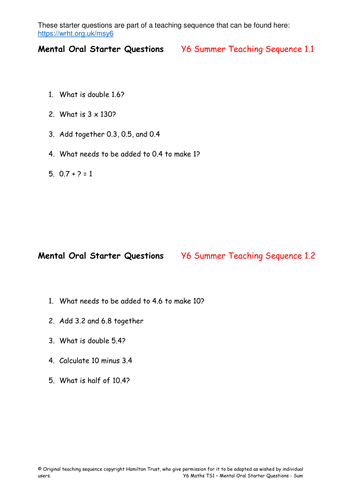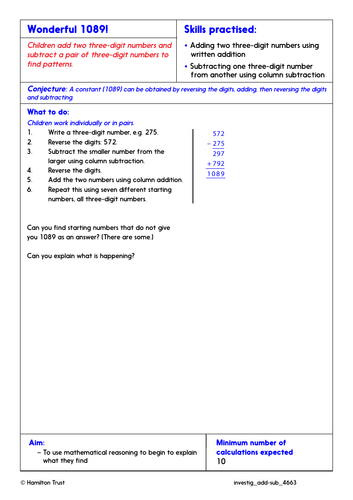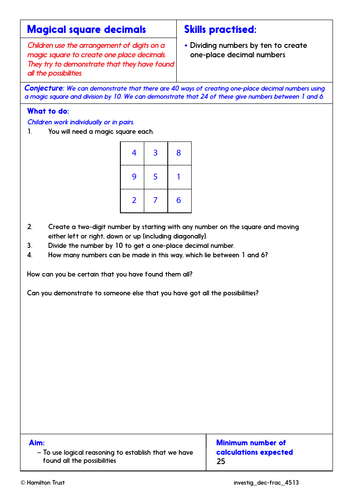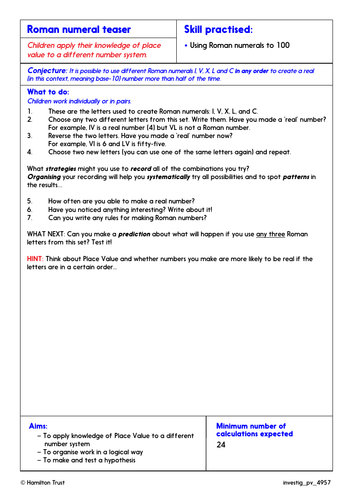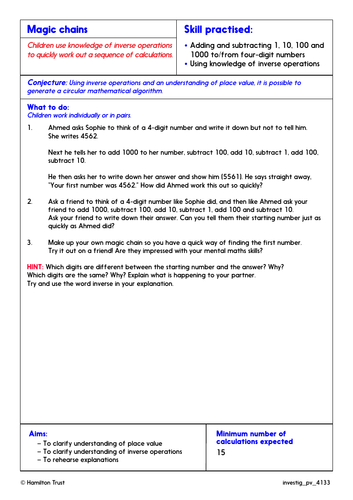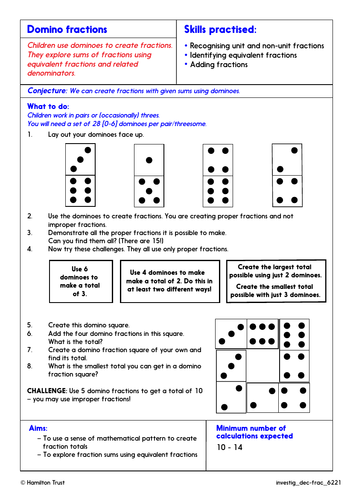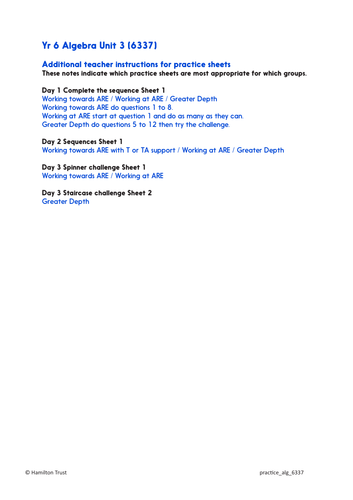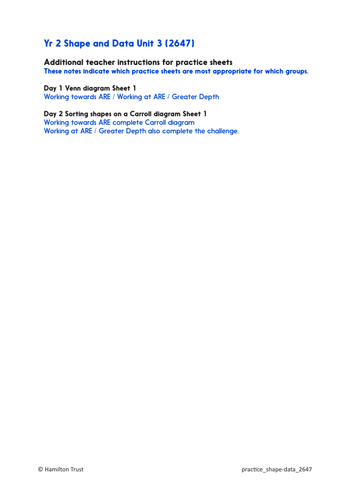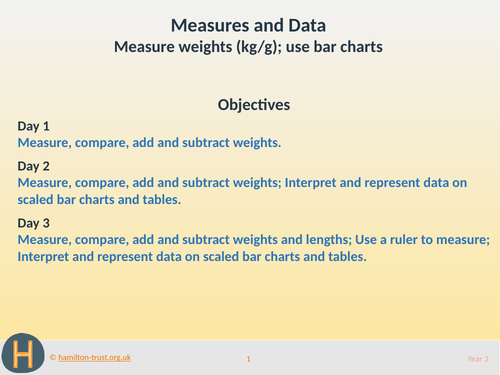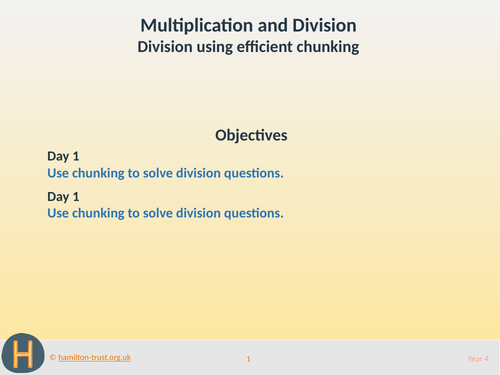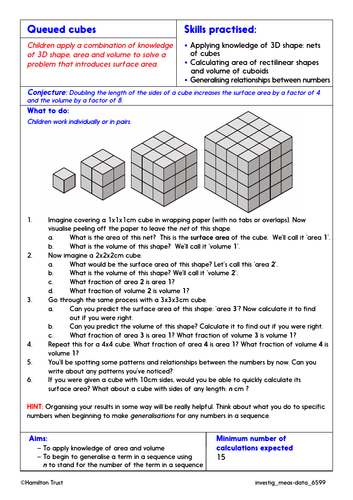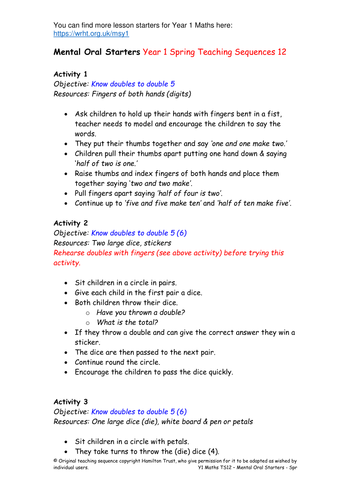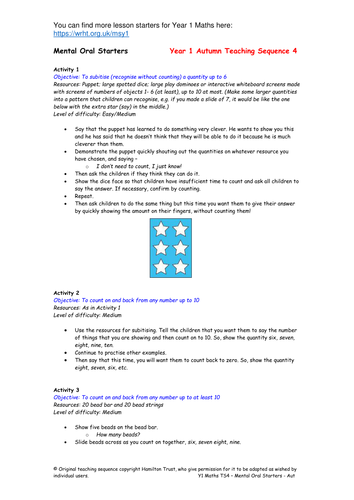
3k+Uploads
10009k+Views
11617k+Downloads
Mathematics

Mental Oral Starter Questions - Year 6
Mental and oral starter questions for Year 6 Summer Teaching Sequence 1.
Find decimals with a total of 1 or 10. Know all multiplication and division facts for the 2 to 10 times tables.
Find additional lesson plans and resources at www.hamilton-trust.org.uk.

Develop the concept of fractions - Problem-Solving Investigation - Year 3
This in-depth maths investigation is an open-ended problem solving activity for Year 3 children. It can be used to support teaching towards the objectives: Develop the concept of fractions.
In-depth Investigation: Fraction Bets
Children look at fractions and make a hypothesis of which ones are closest. They then test this out by placing fractions on a line.
This investigation will develop maths meta-skills, support open-ended questioning and logical reasoning, and enable children to learn to think mathematically and articulate mathematical ideas.
This problem-solving investigation is part of our Year 3 Fractions block. Each Hamilton maths block contains a complete set of planning and resources to teach a term’s worth of objectives for one of the National Curriculum for England’s maths areas.

Subtraction strategies; written methods - Problem-solving Investigation - Year 4
This in-depth maths investigation is an open-ended problem solving activity for Year 4 children. It can be used to support teaching towards the objectives : Subtraction: written methods and choosing strategies
In-depth Investigation: Wonderful 1089!
Children add two 3-digit numbers and subtract a pair of 3-digit numbers to find patterns. They use mathematical reasoning to begin to explain what they find.
This investigation will develop maths meta-skills, support open-ended questioning and logical reasoning, and enable children to learn to think mathematically and articulate mathematical ideas.
This problem-solving investigation is part of our Year 4 Addition and Subtraction block. Each Hamilton maths block contains a complete set of planning and resources to teach a term’s worth of objectives for one of the National Curriculum for England’s maths areas.

Introduction to one place decimals - Problem-Solving Investigations - Year 4
This in-depth maths investigation is an open-ended problem solving activity for Year 4 children. It can be used to support teaching towards the objectives: Introduction to one place decimals.
In-depth Investigation: Magical Square Decimals
Children use the arrangement of digits on a magic square to create one place decimals. They try to demonstrate that they have found all the possibilities.
This investigation will develop maths meta-skills, support open-ended questioning and logical reasoning, and enable children to learn to think mathematically and articulate mathematical ideas.
This problem-solving investigation is part of our Year 4 Decimals and Fractions block. Each Hamilton maths block contains a complete set of planning and resources to teach a term’s worth of objectives for one of the National Curriculum for England’s maths areas.

Doubling and halving - Teaching Presentation - Year 1
This presentation provides two days of teaching that cover the objectives:
Doubling numbers.
Halving numbers.
It includes starter activities, whole class teaching, group activities, practice sheets and mastery questions. It can be used on a variety of interactive whiteboards.
Day 1 Teaching
Explain that when we double a number we add the same amount again, e.g. 2 doubled is 2 + 2 = 4, 3 doubled is 3 + 3 = 6, etc. What is double 10? 10 + 10 = 20. Double 11? We double the 10, (20) and then double the 1 (2). Recombine these amounts to give a total of 22. Provide a visual representation to support visualisation, using base-10 equipment (e.g. Dienes cubes or number shapes such as NumiconTM) to model the partitioning, doubling and recombining steps. Repeat with 12, 13 and 14.
Day 2 Teaching
Explain that halving is sharing the number between two. Demonstrate by sharing four sweets between two children. Repeat with other even numbers up to 20. Odd numbers are harder to share as there is always one left over. Display a bar model to show double 8 is 16. Use this to halve 16. As last time, providing a visual representation using base-10 equipment will support partitioning, halving and recombining.
This teaching is part of Hamilton’s Year 1 Multiplcation, Division and Fractions block. Each Hamilton maths block contains a complete set of planning and resources to teach a term’s worth of objectives for one of the National Curriculum for England’s maths areas.

Count in steps of 25/1000; Roman numerals - Problem-Solving Investigation - Year 4
This in-depth maths investigation is an open-ended problem solving activity for Year 4 children. It can be used to support teaching towards the objectives: Count in steps of 25/1000; Roman numerals.
In-depth Investigation: Roman Numeral Teaser
Children apply their knowledge of place value to a different number system.
This investigation will develop maths meta-skills, support open-ended questioning and logical reasoning, and enable children to learn to think mathematically and articulate mathematical ideas.
This problem-solving investigation is part of our [Year 4 Place Value] (https://www.hamilton-trust.org.uk/maths/year-4-maths/place-value-2/) block. Each Hamilton maths block contains a complete set of planning and resources to teach a term’s worth of objectives for one of the National Curriculum for England’s maths areas.

Problem-Solving Investigation: Place value additions: 4-digit numbers (Year 4 Place Value)
Year 4 Place Value: Add/subtract 1s, 10s, 100s and 1000s to/from 4-digit numbers.
This in-depth Maths Investigation will develop maths meta-skills, and enable children to learn to think mathematically and articulate mathematical ideas.
In-depth Investigation: Magic Chains
Children use their knowledge of inverse operations to quickly work out a sequence of calculations.
This problem-solving investigation is part of our Year 4 Place Value block. Each Hamilton maths block contains a complete set of planning and resources to teach a terms worth of objectives for one of the National Curriculum for England’s maths areas.

Problem-Solving Investigation: Column subtraction, choose strategies. (Y5 Addition & Subtraction)
Year 5 Addition and Subtraction: Column subtraction, and choosing a method.
This in-depth Maths Investigation will develop maths meta-skills, and enable children to learn to think mathematically and articulate mathematical ideas.
In-depth Investigation: Persistent Answers
Children subtract numbers with consecutive digits from numbers with identical digits and record the different possible answers.
This problem-solving investigation is part of our Year 5 Addition and Subtraction block. Each Hamilton maths block contains a complete set of planning and resources to teach a terms worth of objectives for one of the National Curriculum for England’s maths areas.

Problem-Solving Investigation: Equivalent fractions: add and subtract (Year 6 Decimals & Fractions)
Year 6 Decimals and Fractions: Equivalent fractions: compare, add, subtract.
This in-depth Maths Investigation will develop maths meta-skills, and enable children to learn to think mathematically and articulate mathematical ideas.
In-depth Investigation: Domino Fractions
Children use dominoes to create fractions. They explore sums of fractions using equivalent fractions and related denominators.
This problem-solving investigation is part of our Year 6 Decimals and Fractions block. Each Hamilton maths block contains a complete set of planning and resources to teach a terms worth of objectives for one of the National Curriculum for England’s maths areas.

Problem-Solving Investigation: Draw, translate, reflect polygons. (Year 6 Shape)
Year 6 Shape: Draw polygons in all quadrants; translate and reflect these.
This in-depth Maths Investigation will develop maths meta-skills, and enable children to learn to think mathematically and articulate mathematical ideas.
In-depth Investigation: Cycling Co-ordinates
Children use a sequence of co-ordinates to create quadrilaterals.
This problem-solving investigation is part of our Year 6 Shape block. Each Hamilton maths block contains a complete set of planning and resources to teach a terms worth of objectives for one of the National Curriculum for England’s maths areas.

Practice Worksheets: Generate and continue linear sequences. (Year 6 Algebra)
Year 6 Algebra: Generate and continue linear sequences.
Procedural fluency practice Worksheets to achieve maths mastery. Differentiated for children working towards Age Related Expectations (ARE), at ARE and at greater depth.
Day 1 - Work out the step increase/decrease in sequences in order to complete them. Sequences include those which pass through zero, and which increase/decrease by numbers with 1 decimal place.
Day 2 - Children work in pairs to find the 10th, 100th then nth term for sequences.
Day 3 - Draw the next spinner/staircase in a sequence. Find a relationship between the number of shapes in the
spinner/staircase and its position in the sequence.
These procedural fluency practice sheets are part of our Year 6 Algebra block. Each Hamilton maths block contains a complete set of planning and resources to teach a terms worth of objectives for one of the National Curriculum for England’s maths areas.

Practice Worksheets: Sort shapes: Venn and Carroll diagrams. (Year 2 Shape and Data)
Year 2 Shape and Data: Sort shapes according to two overlapping criteria using Venn and Carroll diagrams.
Procedural fluency practice worksheets to achieve maths mastery. Differentiated for children working towards Age Related Expectations (ARE), at ARE and at greater depth.
Day 1 - Sorting numerals into a Venn diagram according to symmetry and straight or curved lines.
Day 2 - Sorting shapes into a Carroll diagram. Create your own Carroll diagram.
These procedural fluency practice sheets are part of our Year 2 Shape and Data block. Each Hamilton maths block contains a complete set of planning and resources to teach a terms worth of objectives for one of the National Curriculum for England’s maths areas.
Bundle

Year 1 Place Value: Problem-Solving Investigations
These in-depth Year 1 Place Value problem-solving investigations will develop maths meta-skills, and enable children to learn to think mathematically and articulate mathematical ideas.
Partition teen numbers; compare numbers to 20
Count to 100 in 1s and 10s
Compare/order numbers < 100
Count to 100 in 1s and 10s; say 1 or 10 more/less
Place value in 2-digit numbers
Compare and order 2-digit numbers using place value
Order 2-digit numbers using place value; say 10 more/less.
In-depth Investigation: Fill in the Box
Children fill a matchbox with items and count them accurately.
In-depth Investigation: Tricky Tracks
Children use reasoning and logic to play ahead in playing a game on a 1-20 track.
In-depth Investigation: Domino Digits
Children find which numbers on a 1 - 100 grid they can make using dominoes - each domino can only be used once.
In-depth Investigation: Pairs in Purses
Children use reasoning and logic to work out pairs of 2-digit amounts that can be made in the two purses given only ten coins.
In-depth Investigation: Calculator Capers
Children create teens numbers using place value additions.
In-depth Investigation: New Neighbours
Children use digit cards to make 2-digit numbers between neighbouring multiples of 10.
These problem-solving investigations are part of our Year 1 Place Value block. Each Hamilton maths block contains a complete set of planning and resources to teach a terms worth of objectives for one of the National Curriculum for England’s maths areas.

Measure weights in g and kg - Teaching Presentation - Year 3
This presentation provides three days of teaching that cover the objectives:
Measure weights in g and kg
Use bar charts
It includes starter activities, whole class teaching, group activities, practice sheets and mastery questions. It can be used on a variety of interactive whiteboards.
Day 1 Teaching
Pass round a 1Kg bag of flour, and then a Kg weight so that children can feel how heavy this is. Then have 2 hoops (<1Kg and >1Kg) and pass objects round the circle. When music stops children place object in correct hoop.
Day 2 Teaching
Have a 1kg bag of flour and a 100g apple. Children pass round different objects and estimate their weights in relation to flour and apples. Use data to create a bar chart.
Day 3 Teaching
Children collect, record and interpret own data. Think of ideas of data they might be able to collect, e.g. Who has the longest index finger? Which is the longest leaf out of a collection? Who has the heaviest lunchbox? Etc.
This teaching is part of Hamilton’s Year 3 Measures and Data block. Each Hamilton maths block contains a complete set of planning and resources to teach a term’s worth of objectives for one of the National Curriculum for England’s maths areas.

Teaching Presentation: Division using efficient chunking (Year 4 Multiplication and Division)
This presentation provides two days of teaching that cover the objectives:
Division using efficient chunking
It includes starter activities, whole class teaching, group activities, practice sheets and mastery questions. It can be used on a variety of interactive whiteboards.
Day 1 Teaching
Write 96 ÷ 6 and read it, reminding children that it asks us how many 6s in 96? Draw an empty number line and model finding 10 lots of 6 and then 6 lots (see download).
Point out that 10 + 6 is 16 so we know there are 16 lots of 6 in 96. Ask children to show 78 ÷ 6 and 72 ÷ 4.
Day 2 Teaching
Show the posters made yesterday. Ask children to share how we use a number line to help us divide. First, we find 10 times the divisor, then we work out how many more lots we need. Model 102 ÷ 6 as 10 × 6 and 7 × 6 on a number line. Repeat for 72 ÷ 4 and 54 ÷ 3.
This teaching is part of Hamilton’s Year 4 Multiplication and Division block. Each Hamilton maths block contains a complete set of planning and resources to teach a term’s worth of objectives for one of the National Curriculum for England’s maths areas.

Strategies in mental and written calculation - Practice Worksheets & Answers- Year 6
Year 6 Place Value, Addition and Subtraction: Informal methods of mental and written calculation.
Procedural fluency practice worksheets to achieve maths mastery. Differentiated for children working towards Age Related Expectations (ARE), at ARE and at greater depth. Includes answers.
Day 1 - Mental addition and subtraction worksheet practice.
Day 2 - Bank Holiday leisure costs, calculating total costs and change.
These procedural fluency practice sheets are part of our Year 6 Place Value, Addition and Subtraction block. Each Hamilton maths block contains a complete set of planning and resources to teach a term’s worth of objectives for one of the National Curriculum for England’s maths areas.

Calculate volumes of cubes/cuboids - Problem-Solving Investigation - Year 6
This in-depth maths investigation is an open-ended problem solving activity for Year 6 children. It can be used to support teaching towards the objective: calculate volumes of cubes and cuboids.
In-depth Investigation: Queued Cubes
Children apply a combination of knowledge of 3-D shape, area and volume to solve a problem that introduces surface area.
This investigation will develop maths meta-skills, support open-ended questioning and logical reasoning, and enable children to learn to think mathematically and articulate mathematical ideas.
This problem-solving investigation is part of our Year 6 Measures and Data block. Each Hamilton maths block contains a complete set of planning and resources to teach a term’s worth of objectives for one of the National Curriculum for England’s maths areas.

Unit and non-unit fraction problems - Problem-Solving Investigation - Year 5
This in-depth maths investigation is an open-ended problem solving activity for Year 5 children. It can be used to support teaching towards the objectives finding an equivalent fraction to non-unit fractions and adding fractions with related denominators.
In-depth Investigation: Big triangle of fractions
Children add fractions with related denominators and find equivalent fractions to identify patterns.
This investigation will develop maths meta-skills, support open-ended questioning and logical reasoning, and enable children to learn to think mathematically and articulate mathematical ideas.
This problem-solving investigation is part of our Year 5 Decimals and Fractions block. Each Hamilton maths block contains a complete set of planning and resources to teach a term’s worth of objectives for one of the National Curriculum for England’s maths areas.

Mental Oral Starters - Year 1
Mental and oral starters for Year 1 Spring Teaching Sequence 12.
Know doubles to double 5. Know doubles of numbers to 10. Begin to know corresponding halves. Find halves of shapes by folding and recognise which shapes are divided and which are not
Find additional lesson plans and resources at www.hamilton-trust.org.uk.

Mental Oral Starters - Year 1
Mental and oral starters for Year 1 Autumn Teaching Sequence 4.
To subitise (recognise without counting) a quantity up to 6. To count on and back from any number up to at least 10. To begin to know pairs that make 10. To begin to know pairs that make 10. Record addition sentences. To know pairs that make 10 and respond to a range of mathematical vocabulary related to addition and subtraction. To recognise sets of numbers without counting them.
Find additional lesson plans and resources at www.hamilton-trust.org.uk.

